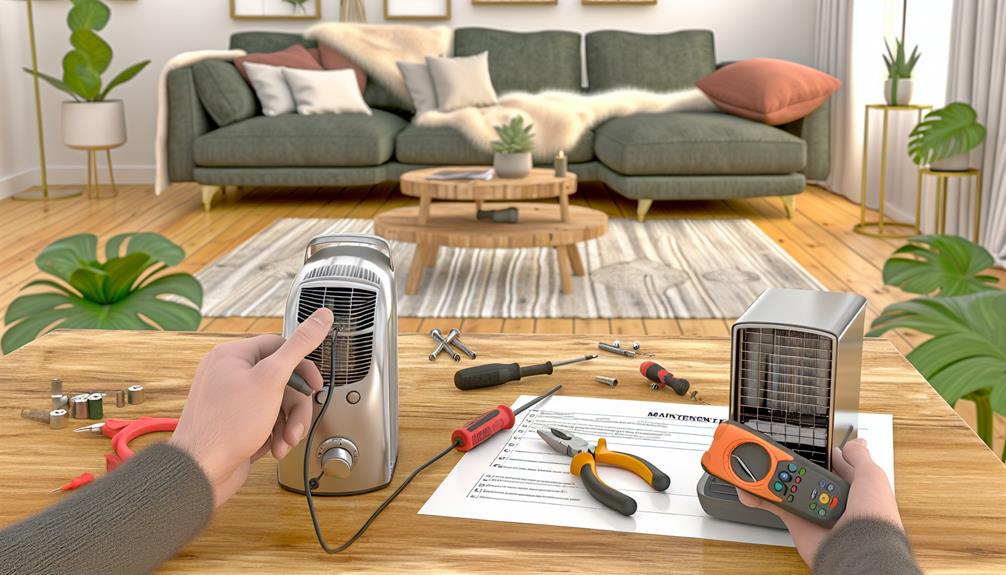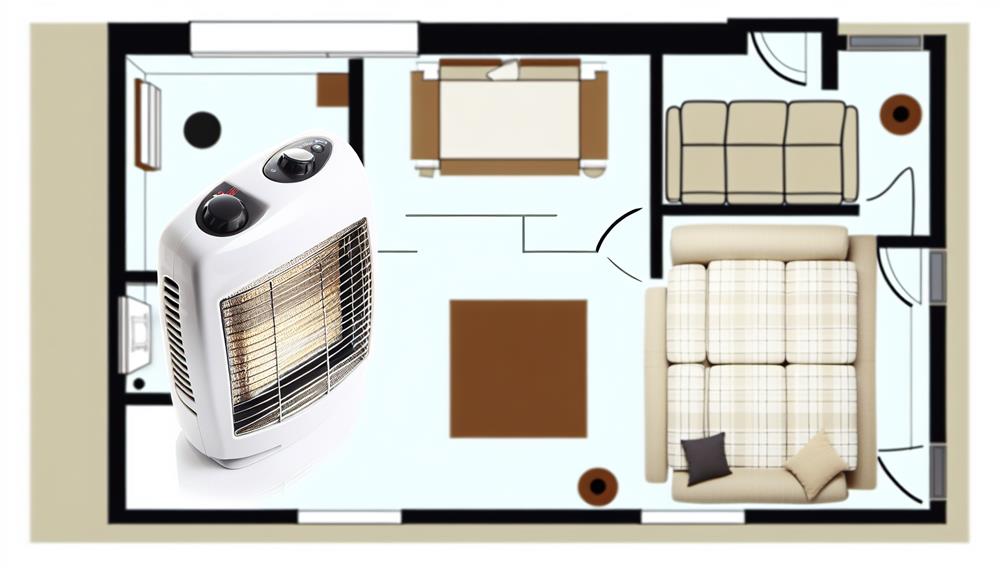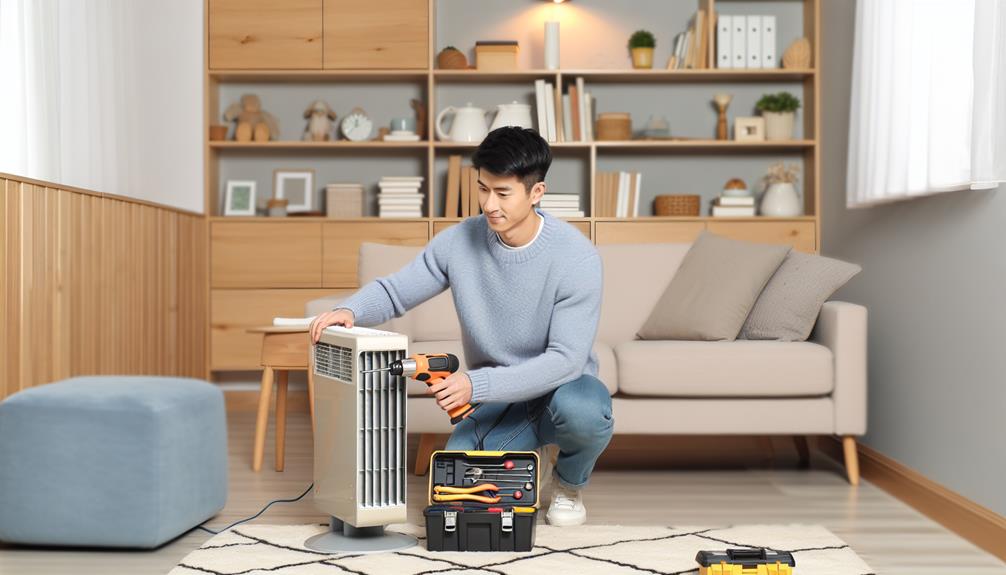As winter's chill seeps through the cracks of your home, you've come to rely on the soft hum and comforting warmth of your portable heater cutting through the cold. You understand it's more than a seasonal companion; it's a crucial appliance that demands attention and care. By adhering to a set of maintenance best practices, you're not only ensuring the longevity of your heater but also the safety and comfort of your space. Let's consider how familiarizing yourself with your heater's specific needs, establishing a routine for regular cleanings, and being vigilant about its operation can prevent those untimely breakdowns that always seem to happen on the coldest nights. Remember, a well-maintained heater is like a trusted friend, steadfast and ready to keep you warm; neglect it, and you might find yourself facing a cold shoulder when you least expect it. Stay with me as we explore how to maintain that warm relationship with your portable heater.
Key Takeaways
- Familiarize yourself with your specific type of heater and its maintenance needs.
- Schedule regular cleanings and maintenance to ensure efficient operation.
- Regularly inspect for damage or wear and address any issues early on.
- Test the safety features of your heater to ensure they are functioning properly.
Understand Your Heater Model
To ensure optimal performance and safety, familiarize yourself with your specific type of heater—be it electric, gas, or oil—along with its particular maintenance needs. Electric heaters convert electrical energy into heat using heating elements, whereas gas heaters combust natural gas or propane, and oil heaters utilize heating oil. Each type of heater has distinct electrical components or combustion systems that require regular inspection and care.
Start by consulting the owner's manual for your portable heater; it's a comprehensive guide to understanding the functional intricacies and maintenance tasks specific to your model. The manual outlines critical procedures and safety guidelines, ensuring you're equipped to handle routine upkeep without compromising the device's integrity or your well-being.
Adhere to a maintenance schedule that reflects the age and usage patterns of your heater, and includes both DIY tasks and professional maintenance. Regularly check for any signs of wear on heating elements, verify the stability of electrical connections, and ensure there's no buildup of dust or debris that could affect performance. For gas and oil types of heaters, monitor the combustion process for efficiency and safety. Professional maintenance is especially crucial for these heaters, as improper handling of fuel systems can pose significant risks.
Schedule Regular Cleanings
Scheduling regular cleanings for your portable heater is essential, as it not only ensures efficient operation but also helps prevent hazardous material buildup that could lead to fire risks. Regular maintenance, including cleaning or replacing filters and wiping down external components, is crucial for your Portable Space Heater to maintain optimal performance. Dust and debris can accumulate over time, impeding airflow and reducing heating efficiency. By routinely removing these obstructions, you'll ensure your space heater operates at its best.
To keep your electric heaters in top condition, follow a detailed cleaning schedule. At least once every month during usage seasons, unplug the heater and let it cool down. Then, remove any visible lint or dirt from the intake grills and exhaust ports using a vacuum with a brush attachment. For internal components that are accessible, consult your heater's manual for guidelines on safe cleaning practices.
Inspect for Damage or Wear

Regular inspections for damage or wear, such as major dents or frayed power cords, are crucial for the safe operation of your portable heater. It's important to thoroughly inspect for damage or wear to prevent any unnecessary wear and tear that could shorten the lifespan of your device. Here are some maintenance tips:
- Visual Inspection:
- Examine the heater for any major dents, dings, or visible damage.
- Check for any signs of overheating, especially on the power cord and around the switches.
- Operational Checks:
- Make sure the switch functions properly without any unusual noises which could indicate internal damage.
- Test the heater to identify and address any performance issues early on.
During your maintenance routine, also ensure you replace filters as needed, to maintain optimal air quality and heater efficiency. Pay attention to any visible damage or potential safety concerns you might uncover. If you do find damage or issues, it's essential to take immediate action to rectify them, be it through repair or replacement of the affected parts. This level of diligence will keep your portable heater in top shape, providing you with reliable warmth whenever you need it.
Test Safety Features
You need to inspect the automatic shutoff system of your portable heater to confirm it activates promptly when necessary. Ensure the overheat protection mechanism is responsive by monitoring the heater's temperature control features. Conducting these tests regularly mitigates risks and guarantees your heater operates within safe parameters.
Inspect Automatic Shutoff
Testing your portable heater's automatic shutoff feature is crucial to ensure it activates immediately in the event of a hazard, such as overheating or tipping over. Conduct a thorough examination of the mechanism to:
- Inspect Automatic Shutoff:
- Ensure no visible signs of wear or damage.
- Confirm the shutoff engages promptly for safety hazards.
- Test Safety Features:
- Verify the heater ceases operation when a risk is detected.
- Check the response of moving parts within the heat exchanger.
Address any issues you uncover during this inspection. If you notice any damage or malfunction, it's essential to resolve these concerns before continued use. Regular checks of your portable electric heater's safety features are not just practical; they're vital for preventing accidents and maintaining efficient operation.
Verify Overheat Protection
After inspecting the automatic shutoff, it's critical to verify the overheat protection mechanism to ensure it cuts power to the heater before temperatures reach hazardous levels. This safety feature guards against potential fire hazards by automatically halting the heating process if the internal temperature of your space heater soars too high. To test this, run your heater and monitor its response to increased heat. It should shut off when it surpasses a specific temperature threshold. Regular checks of the overheat protection will keep this function sharp and prevent damage to the heater or surrounding area. Don't overlook this step, as a non-functional overheat protection can lead to serious safety issues during operation.
Maintain Proper Placement

To ensure your portable heater operates safely, you must adhere to safe distance guidelines; keep it at least 3 feet from combustibles. Position the heater on a stable, flat surface to prevent any accidental tipping. Consult the owner's manual for additional placement instructions specific to your model, ensuring it's clear of water sources and flammable materials.
Safe Distance Guidelines
Ensure you maintain at least a 3-foot clearance between your space heater and any combustible materials for optimal safety. This safe distance guideline is crucial for various types of heating systems, including gas heaters, to function efficiently and economically. Adhering to these guidelines not only increases the temperature in your space safely but also extends the life of your heater.
Here's how to maintain proper placement:
- For Gas Heaters:
- Regularly check and replace filters to ensure unobstructed airflow.
- Verify that ventilation requirements are met to prevent carbon monoxide buildup.
- For All Heater Types:
- Place on a hard, level surface away from flammable materials.
- Ensure the area around the heater remains clear to minimize fire risk.
Optimal Location Tips
Building on the importance of maintaining a safe distance, identifying the optimal location for your portable heater is equally crucial for its safe and efficient operation. During winter, it's vital to keep your heating system functioning optimally. Place your heater on a hard, level surface to maintain stability and ensure consistent heating; this also promotes better indoor air quality by preventing obstructions to airflow. Avoid positioning oil heaters, which produce heat through combustion, near combustible materials. Keep the unit at least 3 feet from such items, and ensure it's not blocking vents and ducts to avoid disrupting the circulation of warm air. Always consult the owner's manual for model-specific guidelines and place the heater away from water sources to prevent electrical hazards.
Change or Clean Filters
Maintaining your portable heater's performance requires regular checks and cleaning or replacement of its filters, as per the manufacturer's specifications. It's critical to ensure the air flowing through your heater is as clean as possible; not only for efficiency but for your health as well. Filters are often overlooked components, yet they play a vital role in keeping the heater functioning properly, especially during the heavy-use winter months.
Here's what you need to remember:
- Regular Maintenance:
- Check filters at least once a year; more frequently if used heavily.
- Make sure to follow the specific guidelines provided by the heater's manufacturer.
- Efficiency and Air Quality:
- Clean or replace filters to reduce the amount of dust and debris in the air.
- A clean filter ensures optimal airflow and heater efficiency.
Dirty or clogged filters can impede airflow, leading to reduced heater effectiveness and potentially higher energy costs. By keeping filters clean, you not only improve the air quality but also contribute to the heater's energy efficiency, which can help reduce heating costs and prolong the lifespan of your unit. Remember, a little maintenance goes a long way in keeping your space warm and your heater in top condition.
Monitor and Adjust Settings

Regular monitoring and adjustment of your portable heater's settings can significantly enhance its efficiency and warmth output, tailoring the heat to your specific comfort levels and conserving energy. Precisely calibrating the thermostat settings is crucial to prevent your energy bills from escalating during the winter season. An optimized thermostat not only delivers the right amount of warm air but also reduces strain on the power supply.
Monitoring your heater's temperature settings is another vital practice. High temperatures can cause damage to internal components and, in the case of gas heaters, could lead to serious hazards like gas leaks. Therefore, you should ensure the settings align with safety standards and the manufacturer's recommendations.
The fan speed and heat output should be adjusted according to the room size and your heating needs. A smaller room may require less heat, and a lower fan speed will distribute the warm air adequately while conserving energy. Conversely, larger spaces may need a higher setting for effective heating.
Adapting to changes in environmental conditions and personal preferences is essential. If sunlight increases room temperature, lower the heater's setting to maintain comfort without wasting energy. Continuous adjustments keep your portable heater running optimally, safeguarding both your comfort and your wallet.
Seek Professional Inspections
To ensure your portable heater's optimal performance and safety, it's essential to periodically seek professional inspections that can uncover and rectify any underlying issues. By doing so, you take care of potential problems that could compromise your heater's efficiency or, worse, pose safety hazards.
Here's why and how to achieve better peace of mind with professional servicing:
- Identify Potential Hazards:
- *Highly Flammable Materials*: Professionals can assess and advise on the safe placement of your heater, particularly in areas where there may be combustible materials.
- *Electrical Issues*: Experts ensure all electrical connections and components are up to standard, mitigating risks of shorts or fires.
- Optimize Heater Performance:
- *Efficiency Checks*: Technicians can fine-tune your heater's operation to ensure you're getting the most heat for the least energy.
- *Wear and Tear*: Regular inspections can catch wear before it leads to failure, extending the lifespan of your heater.
Seek professional inspections at least once a year, or more frequently if you notice any irregularities. If your heater starts acting up, don't wait—get it checked as soon as possible. This proactive approach ensures your heater runs smoothly, keeping you warm without any unwanted surprises.
Frequently Asked Questions
How Do You Maintain a Portable Heater?
You'd think maintaining a portable heater is rocket science, but it's simpler. Clean regularly to avoid turning it into a dust bunny haven. Inspect cords for a spark-free experience. Replace filters, or you're just recycling dirt. Check safety features unless you fancy a firework display. Store properly—no, it's not a doorstop. Follow instructions unless you're better than the manufacturer. Monitor performance; it shouldn't double as a freezer. Stay warm and safe!
When You Use a Portable Heater You Should Keep It?
When using your portable heater, you should ensure proper heater placement, prioritize dust removal, and conduct safety checks. Adequate ventilation space is crucial, as is diligent cord care. Regular thermostat calibration optimizes performance, while monitoring usage frequency prevents wear. These steps, technical and detailed, are practical for maintaining your heater's efficiency and safety, without delving into broader maintenance best practices.
What Are the Best Practices for Heaters?
To ensure your heater's performance, follow these best practices: adhere to safety precautions, maximize energy efficiency, and stick to usage guidelines. Regular dust removal boosts functionality, while adhering to ventilation requirements ensures safety. Implement a strict inspection schedule to catch issues early, and when not in use, follow proper storage tips to prolong its life. These practical measures keep your heater reliable and efficient.
How Do I Maintain My Heating System?
To maintain your heating system, prioritize heating efficiency by regularly cleaning filters and performing ventilation checks. Monitor energy consumption to identify potential issues. Don't skip safety inspections or thermostat calibration; these ensure your system runs effectively. Consider system upgrades for better performance and sustainability. Always be vigilant about maintenance to prevent costly repairs and ensure your heater's longevity. Proper care keeps you warm and safe.
